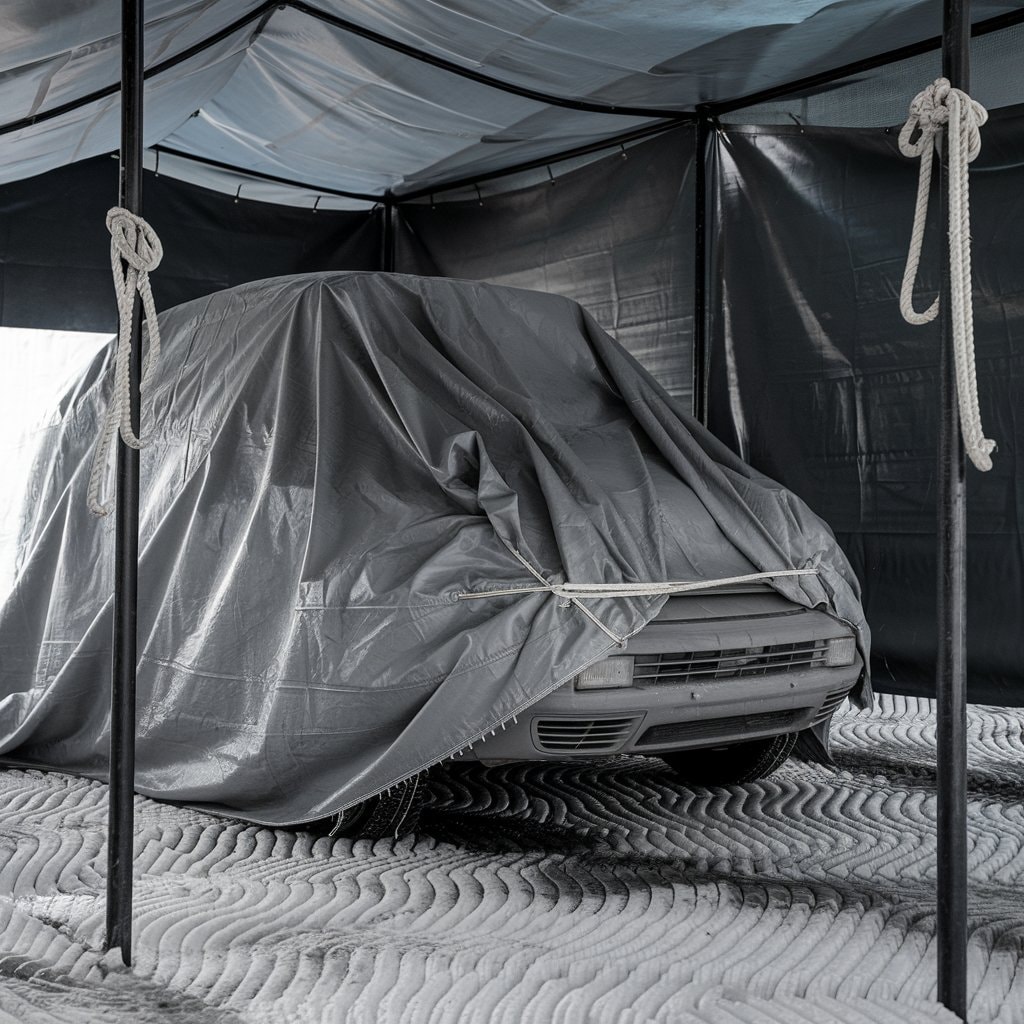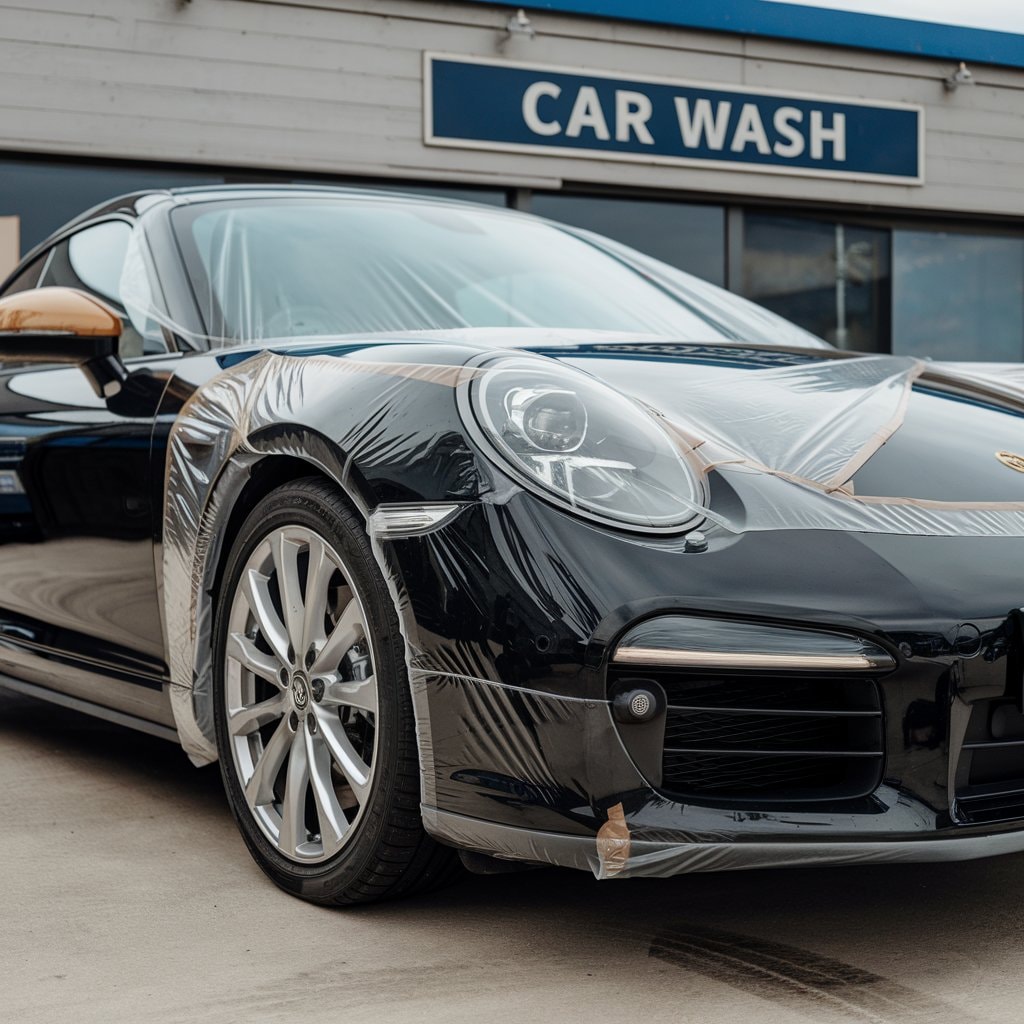To protect a car from scratches and maintain its new appearance, apply paint protection film (PPF) and consider ceramic coatings for additional protection. Regular use of car wax can also shield the paint from minor blemishes. Utilizing microfiber towels for cleaning helps avoid surface damage. For best care, choose parking spot wisely and perform consistent maintenance on protective treatments. These steps provide substantial defense against scratches, revealing more techniques will further safeguard the vehicle’s exterior.
Key Takeaways
- Apply paint protection film (PPF) to high-impact areas for a durable scratch barrier.
- Regularly wax your car to enhance the paint’s gloss and scratch resistance.
- Use microfiber towels and proper car wash methods to avoid surface scratches.
- Park in spacious areas to reduce the risk of scratches from other vehicles.
- Maintain the car’s protective coatings with regular detailing and inspections.
How to Protect Car from Scratches?
To effectively protect a car from scratches, it is essential first to understand the common causes, which can range from environmental factors to everyday use.
Employing preventative measures such as using high-quality car covers and applying sealants or ceramic coatings can greatly shield the paint.
Additionally, regular maintenance, including proper washing and waxing techniques, plays an important role in preserving the car’s exterior from potential damage.
What Causes Scratches on Your Car?
Understanding the common culprits behind scratches on your car is crucial for preserving its aesthetic appeal and structural integrity.
Here are four primary sources of car scratches:
- Automatic Car Washes: The abrasive brushes and harsh chemicals used can create swirl marks and minor scratches, compromising the car paint.
- Improper Cleaning Tools: Using rough cloths or sponges can introduce deep scratches, especially when dirt or sand is present.
- Careless Parking: Choosing a tight parking spot increases the risk of scratches from nearby vehicles or passing traffic.
- Lack of Protective Measures: Not using a car cover leaves the vehicle exposed to environmental elements and accidental scrapes, which can deteriorate the paint over time.
How Can You Protect Car Paint
Knowing the sources of car scratches allows vehicle owners should take proactive measures to protect their car’s paint.
Applying a paint protection film creates a protective layer that shields the paint from scratches, debris, and environmental factors. This film maintains the clarity and shine of the car’s original paint while preventing minor scratches and swirl marks.
Additionally, regular applications of car wax enhance the clear coat’s ability to repel dirt and reduce scratch visibility. For ongoing maintenance, using a specific cleaning solution designed for cars helps avoid the abrasiveness found in regular detergents.
Car detailing services often recommend a ceramic coating, and considering the tips mentioned, it adds another layer of protection, ensuring the paint’s longevity and maintaining the vehicle’s aesthetic appeal.
What are the Best Ways to Protect Your Car’s Paint?
Several effective strategies can be employed to protect your car’s paint from scratches, each varying in application technique and durability.
Here are four pivotal methods:
- Apply Car Paint Protection Film: Install a high-quality paint protection film (PPF) to act as a barrier against scratches, maintaining your car’s pristine look.
- Use the Two-Bucket Method: When washing, employ the two-bucket method to minimize dirt reapplication, which can cause scratches.
- Choose Your Parking Spot Wisely: Avoid parking your car in tight or overcrowded areas to reduce the risk of accidental scratches.
- Use Clean Microfiber Towels: Always clean your vehicle with microfiber towels to protect the car from scratches, ensuring fibers trap particles without damaging the surface.
Is Using a Car Cover Effective in Preventing Scratches?
Car covers are commonly advocated for as an effective measure in shielding vehicles from external abrasions, including scratches.
When selecting a car cover, it is key to contemplate the material, fit, and environmental factors that align with the vehicle’s storage conditions.
While car covers can mitigate many surface scratches, it is important to recognize that not all types of scratches can be prevented by this method alone.
Benefits of Using a Car Cover
Using a car cover can greatly reduce the risk of scratches and minor abrasions that often result from exposure to environmental elements.
When considering a car cover to shield your vehicle, it’s important to recognize its efficacy in preserving the car’s finish. Here are some key advantages:
- Protection from Scratches: Shields the vehicle’s surface from potential scratches, safeguarding the car’s exterior surface.
- Guard Against Elements: Protects against environmental factors like dust, sap, and bird droppings that can damage the car’s finish.
- Preserve Paint: Helps maintain the integrity of the paint by minimizing exposure to UV rays and moisture, which can fade and corrode the surface.
- Enhanced Longevity: By consistently using a car cover, the overall durability and appearance of the car are enhanced, preventing premature wear.

How to Choose the Right Car Cover
Choosing the right car cover involves considering materials that offer an extra layer of protection while being gentle on the car’s paint. A high-quality cover designed for paint protection film car applications is essential.
It should be breathable to prevent moisture accumulation, which can damage the vehicle’s exterior. Additionally, the cover must shield the car paint from UV rays, further protecting your car and keeping the car looking new.
Opt for a cover that fits snugly to avoid it being blown away or rubbing against the car’s surface, which might cause scratches.
Prioritize car care by selecting a cover that complements these protective features.
Can a Car Cover Prevent All Types of Scratches
While a car cover can serve as an invisible shield, mitigating the risk of scratches and paint damage, it is not an all-inclusive solution.
Here’s how it contributes to protecting your vehicle:
- Superior Protection: A high-quality car cover can protect your car from everyday wear, dust, and minor abrasions.
- Avoid Direct Impacts: It cannot guard against more severe impacts or deliberate vandalism.
- Enhanced Safeguard: Combining a car cover with car ppf (paint protection film) and protective waxes can offer more extensive protection.
- Limitations: Sharp objects or heavy falling debris will surpass the protective capabilities of a typical car cover.
Utilizing a car cover is a practical step in a broader strategy to prevent car scratches.
Should You Avoid Automatic Car Washes?
When considering whether to use automatic car washes, it is essential to assess if these facilities might scratch your vehicle.
Alternatives to automatic car washes, such as hand washing or touchless wash systems, offer potentially safer methods for maintaining a car’s exterior.
Understanding the proper techniques for washing your car can greatly reduce the risk of inflicting scratches during the cleaning process.
Do Automatic Car Washes Cause Scratches
Many car owners wonder whether automatic car washes are responsible for scratches on their vehicles. The concern is valid, as certain factors can indeed increase the risk of scratches to the car’s surface.
Here are four key considerations:
- Brush Quality: Older or poorly maintained brushes in automatic washes can cause fine scratches and swirl marks due to trapped debris.
- Harsh Detergents: Strong chemicals may strip away waxes or sealants, exposing car paint to scratches.
- Improper Drying Techniques: Using non-absorbent, rough towels can inflict light scratches during the drying process.
- Frequent Usage: Regular exposure to automatic washes can aggregate minute damages, cumulatively harming the car’s finish.
Adopting proper care, including using microfiber towels and ensuring proper drying techniques, can mitigate these risks.
What are the Alternatives to Automatic Car Washes
Given the potential risks associated with automatic car washes, many vehicle owners explore alternative methods to keep their cars clean without compromising the paint’s integrity. Washing the car by hand is a preferred method, utilizing clean microfiber towels and protective waxes to shield the surface from road debris and small scratches. This approach not only allows for meticulous attention to detail but also avoids the harsh brushes of automatic car washes.
| Method | Benefits |
|---|---|
| Hand Washing | Control over cleaning, reduces scratches |
| Quality Paint Protection Film | Guards against elements and minor abrasions |
| Regular Application of Wax | Adds a layer of protection, enhances shine |
| Parking Strategically | Avoids crowded streets and tight spaces |
How to Wash Your Car Safely
Several car owners opt to wash their vehicles manually to mitigate the risk of scratches and damage often associated with automatic car washes.
Washing your car by hand allows for a gentler approach, where one can control the contact and pressure applied to different parts of the vehicle, such as the side mirror and other elements that might be more vulnerable.
Here are reasons why manual washing is preferred:
- Preservation: Hand washing prevents automatic brushes from stripping protective waxes and sealants from the paint.
- Precision: Focus on natural obstacles and sensitive areas, ensuring thorough cleaning.
- Protection: Spray on PPF in your garage to shield against minor abrasions.
- Personalization: Customize your cleaning process, finding the best solution tailored to your car’s specific needs.

How to Maintain Your Car to Prevent Scratches
Maintaining a car regularly to prevent scratches involves several proactive steps.
Regular car detailing not only keeps the vehicle looking pristine but also adds a protective layer against minor abrasions.
Careful parking can avoid unnecessary contact with other vehicles or objects while understanding how to manage minor scratches and swirl marks can maintain the car’s aesthetic value.
Regular Car Detailing Tips
Regular car detailing is vital in preventing scratches and maintaining the aesthetics of your vehicle.
Here are four important car detailing tips to protect your car from scratches and keep it looking its best:
- Wash Regularly and Properly: Use a high-quality car shampoo and a microfiber cloth to gently clean the car, reducing the risk of fine scratches and abrasions.
- Apply a Protective Wax: Waxing provides a protective layer that minimizes the impact of minor scratches and keeps the surface glossy.
- Use Paint Sealants: Sealants offer a longer-lasting solution than wax, shielding the paint from environmental elements and debris.
- Invest in High-Quality Cleaning Tools: Always opt for soft brushes and specialized cleaning products designed for automotive use to guarantee the vehicle remains free from scratches.
Why is Parking Your Car Carefully Important
While expert detailing plays a critical role in maintaining your car’s appearance, careful parking is equally essential to prevent scratches and other forms of physical damage.
Parking your car carefully avoids placing it too close to other cars, which might lead to scratches that damage the paint. Tips on how to protect cars from scratches include choosing wider parking spaces and avoiding areas with high vehicle turnover.
The best solution to protect the car from scratches is to be mindful of the surrounding environment and how you position your vehicle. Such practices not only preserve the aesthetic appeal but also uphold the car’s resale value by minimizing avoidable wear and tear.
Careful parking is a proactive step in safeguarding your investment.
How to Handle Minor Scratches and Swirl Marks
Addressing minor scratches and swirl marks promptly can greatly extend the life and appearance of your car’s paintwork.
Here’s a methodical approach to managing various scratches that affect the car paint:
- Evaluate the Damage: Inspect the scratched car carefully to determine if the scratches are superficial or deeper scratches that penetrate the clear coat.
- Clean the Area: Wash the surrounding paintwork to remove dirt and debris that could cause further damage when repairing.
- Apply Scratch Remover: Use products with self-healing properties designed to fix car scratches. For deeper scratches, a spray gun may be needed to apply paint precisely.
- Polish and Wax: After repair, polish and wax the area to blend the repair with the existing paint and enhance protection.
What is the Role of Wax in Car Paint Protection?
Car wax plays an essential role in enhancing the durability and effectiveness of Paint Protection Film (PPF) by adding a layer of protection against environmental elements.
Various types of car wax, including synthetic and natural options, offer different benefits and longevity, impacting how frequently a car needs waxing.
Typically, it is recommended to apply car wax every three to four months to maintain ideal protection and shine on the vehicle’s surface.
How Does Car Wax Protect Car PPF
Applying wax to a car’s Paint Protection Film (PPF) enhances its durability and efficacy in safeguarding the vehicle’s exterior.
Car wax acts as a protective overlay that not only intensifies the gloss but also adds a robust defense against environmental contaminants. This additional layer is essential for any car enthusiast wanting to maintain the best car appearance and integrity for years.
- Enhances Gloss: Car wax amplifies the sheen of the PPF, making the car look continually new.
- Repels Dirt and Water: It causes debris and water to bead up and slide off, minimizing scratches.
- UV Protection: Shields the PPF from sun damage, preserving the film’s clarity and color.
- Longevity: Wax extends the life of the PPF, ensuring 200 microns of protection remain effective longer.
What are the Different Types of Car Wax
Understanding the different types of car wax and their specific roles in paint protection is essential for any vehicle owner looking to maintain an immaculate exterior.
Car owners who want to protect their vehicle’s paint from environmental hazards like bird droppings, which might scratch the car, can choose from several types of wax.
Natural carnauba wax is prized for its deep, rich shine and durability, making it ideal for high-impact areas like the front bumper.
Synthetic polymer waxes, on the other hand, form a strong protective seal that can prevent dirt and residues from being transferred back onto the car over an extended period.
How Often Should You Wax Your Car
How frequently should you wax your car to maintain its paint protection? Waxing plays an essential role in preserving your vehicle’s finish, especially when maneuvering through narrow streets where scratches from close brushes with walls and other vehicles are more likely.
Consider the following guidelines:
- Seasonal Changes: Wax your car quarterly to protect against varying weather conditions.
- Environmental Factors: If you often drive on narrow streets with potential abrasive contact, increase waxing frequency.
- Car Usage: More frequent trips necessitate more regular wax applications.
- Wax Type: Durability varies by product; check manufacturer recommendations to optimize protection.
Exploring Paint Protection Film and Ceramic Coating
Paint Protection Film (PPF) is a clear, urethane material applied to the exterior of vehicles to safeguard against scratches and chips.
Ceramic coating, on the other hand, involves applying a liquid polymer that chemically bonds with the car’s paint, creating a durable layer of protection.
Comparing these two, it is essential to evaluate their effectiveness, longevity, and cost to determine which option better suits individual needs for car paint protection.
What is Paint Protection Film
To shield a vehicle’s paint from scratches, stains, and environmental damage, many car owners turn to paint protection film, a clear, durable urethane material.
This film is meticulously applied to the car’s most vulnerable areas, such as the hood, bumpers, and door edges.
Here are the key benefits:
- Preservation of Paintwork: Protects against minor abrasions and UV rays, maintaining the original appearance.
- Enhanced Durability: Offers a long-lasting barrier against road debris and chemical contaminants.
- Cost Efficiency: Reduces the need for frequent repaints, saving money in the long run.
- Resale Value: Maintains higher vehicle resale value by preserving the exterior in pristine condition.
These advantages make paint protection film a prudent investment for any vehicle owner.
How Does Ceramic Coating Work
While paint protection film offers a robust defense against physical abrasions, the ceramic coating provides a different form of protection by creating a chemical polymer solution that bonds with a car’s paint.
This bond forms a hydrophobic (water-repellent) layer on the surface that enhances gloss and preserves the underlying color from UV damage.
The application process involves thoroughly cleaning the vehicle’s surface to remove any contaminants. After this, the coating is applied meticulously, usually in a controlled environment, to prevent dust from settling on the surface during the curing process.
Once cured, the ceramic coating acts as a protective shield against environmental contaminants like dirt, oil, and bird droppings, making cleaning easier and less frequent.
Paint Protection Film vs. Ceramic Coating: Which is Better?
How does one decide between paint protection film and ceramic coating when looking to safeguard a vehicle’s exterior? Both options offer distinct advantages and cater to different protection needs.
- Durability: Paint protection film generally offers a thicker barrier against physical damage like scratches and stone chips.
- Longevity: Ceramic coatings, while thinner, provide a hard layer that can last for several years, depending on the product quality.
- Appearance: Ceramic coatings enhance the car’s shine and color depth, making it vibrant and glossier.
- Maintenance: Ceramic coatings also make cleaning easier due to their hydrophobic properties, which repel water and dirt.
Deciding between them depends on prioritizing physical protection or long-term ease of maintenance.
Conclusion
In summary, protecting a car from scratches involves a combination of regular maintenance and protective measures. Utilizing car covers can shield from environmental elements. Avoiding automatic car washes and opting for manual washing can prevent abrasive damage. Regular waxing plays an essential role in creating a protective barrier on the car’s paint. Additionally, investing in paint protection film or ceramic coating offers a more durable solution, preserving the vehicle’s aesthetic appeal and maintaining its value.






